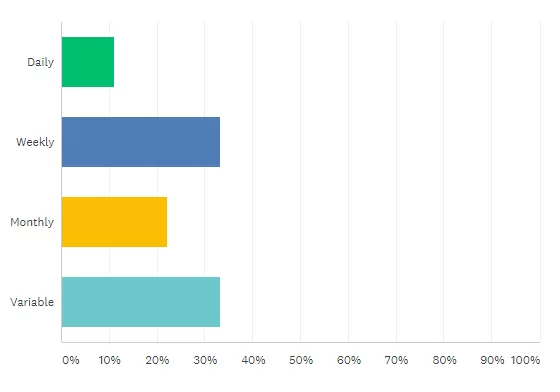Ad Budgeting has traditionally been one of the most difficult tasks for marketing teams. The age-old anecdote was, “I know half of my ad budget is being wasted, but I don’t know which half”. With the advent of digital media, the sophistication of measurement tools has increased, however, there are still several layers of nuance to consider. Paid Social is among the most complex channels to determine a final budget number. Reason being, many ad operators have to work backward from a target ROI, which can require monthly, weekly, or even daily spend adjustments.
Planning for the year and allocating resources is a primary responsibility and a key to success. From that higher level, we drill down to quarters, months, departments, and channels. It is one of our best opportunities for setting our teams up for success.
Budgeting processes can vary between feeling like putting our fingers in the air for a feel-based guess, to a continuation of what we are doing this / last year, to “herding cats” in an effort to keep all stakeholders on our team happy and motivated. The pace of tech change is quickening, some channels are improving in effectiveness while the impact of others diminishes, and some tactics integrate better than others. There are a lot of moving parts, and aligning them in the interest of optimal performance can be challenging.
Aside from the most experienced marketing leaders, CMOs can often be limited to the viewpoint and collective experiences of our immediate teammates and partners.
For an ascending and technically detailed channel like paid social (Facebook and Instagram ads), the moving parts can feel even more daunting.
Over 5 years of discussions with CMOs, VPs of Marketing, and Marketing Directors, here are some of the most common mental models and constructs that surface in the discussions of how much to spend on Facebook (and Instagram) ads when deciding:
How Much Should an E-commerce Company Budget for Paid Social?
- Testing phase
- Unit economics focused (CAC vs LTV)
- Paid Social as a percentage of (digital) marketing budget
- The impact of COGs, marginal cost, and variable cost
- Why many e-commerce companies leave money on the table when they think they’re winning at paid social
There are differing theories on how to budget but the process needs to begin with getting a good understanding of the metrics. In terms of paid social, primarily Facebook and Instagram, that involves properly installing the Facebook Pixel to not just capture purchases or leads but also revenue (in the case of e-commerce). Relying on Google Analytics simply isn’t enough to get the complete picture on how much revenue Facebook is driving for our businesses.
Of course, if our e-commerce business also sells on other channels like in a brick-and-mortar retail store, through distribution partners or a channel like Amazon it is important to consider how paid social may boost other channels’ performance. Refining and understanding measurement of all channels is necessary for proper analysis before, during, and after budgeting season.
Once the pixel is in place, you are ready for the learning phase. If you have spent much time in Paid Social you know that this is basically an ongoing phase. You never totally solve the proper mix of targeting, budgeting and creative. However, over the course 1-6 months in the platforms you start to understand our basic scaling components; cost per purchase and revenue per purchase.
At this point, most businesses would say, “GREAT, let’s scale this thing!” Unfortunately, this is where the even harder work begins. This is where initial unit economics come in, What does it really cost to make, market, sell and fulfill the product on Paid Social? How much labor is involved? Is an agency collecting fees? What are shipping/fulfillment costs? Once you understand the true cost then comes to the even harder LTV (Lifetime Value) calculation.
Let’s dive a bit deeper on each of the 5 mental models we outlined above. These are not exhaustive or mutually exclusive; there is a lot of overlap between them and most companies use more than one of the below constructs when setting paid social ad spend budgets:
1. Testing phase: this is where Facebook ad campaigns live for the vast majority of the time. On a platform that changes continuously with a 20% variance in daily performance data, everything is a test. The question becomes how to best run ad tests on Facebook and Instagram? That is a subject of another post, but the most common sense rule we always come back to for e-commerce is a daily testing budget of 6x target CPA. This allows enough volume to be able to test with velocity. So for example, for a shoe retailer like Seavees, you might expect an average order value in the range of $175, and we might set a target CPA (ad spend per purchase) of 30% for a specific early test period, so target CPA is $53. One metric we would cite in the budget discussion then would be a daily ad spend budget of $318 (6*53).
Typically driving down the target CPA (ie far below $53 per purchase in the above example) would be when we would collectively decide to scale ad spend.
2. Unit economics focused (CAC vs LTV): this is akin to a “golden rule” for e-commerce business models, featured in the dreams of VC associates and scaling e-commerce business owners alike. CAC vs LTV refers to the relationship of “Customer Acquisition Cost” (CAC) and the “Lifetime Value” (LTV) of a company or product.CAC is often used interchangeably with CPA (Cost per Acquisition), CPL (Cost per Lead), and depending on the business model Cost per Purchase, Cost per Sale, and Cost per Ticket Sold. All different ways of answering the same question: how much ad spend does it take to acquire a customer?(LTV is a simple concept also: what is the value of profit or revenue that my company gains in the lifetime of the average customer? A simple concept, yet highly nuanced when you drill down into specifics. For a deeper dive, check out our Matchcast podcast on LTV .)BOTTOM LINE: we all want to live in a world where lifetime value (LTV) is GREATER THAN customer acquisition cost (CAC)
3. Paid Social as a percentage of (digital) marketing budget: this is a simple practicality for many larger and more mature businesses. Our friends in the hotel industry are a good example of a realm in which hard budgets are set annually, marketing is often determined as a percentage of revenue (or a small % increase or decrease from the previous year), digital marketing budget is a percentage of marketing, and paid social is a percentage of digital.
Many businesses at one point or another look it as a pie that gets sliced:
“Quite simply, I take my total budget for that campaign and generally divide by the # of ad sets I have. That’s most of the time. Other times may be based on if I have an ad set that I know already works, I’ll pour more money into that vs. a new, separate test I have going”
–Adam Bianco, CEO of Travel Collectibles.

For an e-commerce business, certainly these internal analyses are done on a rolling basis, but budgets tend to be more results driven (see the above “if CPA is below our profit threshold on a unit economics level, let’s spend more!”).
4. The impact of COGs, marginal cost, and variable cost: we have seen businesses with low cost of marginal sale (marginal COGs) aim for a paid social CPA up to 90% of LTV. This is an extreme example and usually only applies to digital products (for example, selling videos to help with back pain) like software and SaaS. Most businesses have a cost of the product that needs to be baked into their unit economics equations. For example, in our work with New Balance, we know that the cost of the shoes themselves were about 50% of revenue, so all other costs (and profit) including paid social spend had to fit within the other 50% of sales for a particular transaction. For an “average” business, very frequently we start the discussion by considering if spending 30% of revenue on ads might be sustainable. If so, we may talk about moving up from 30% of revenue as allowable CPA, and some other businesses with tighter margins (hotels, brick and mortar retail) may need to aim for target CPA numbers between 5% and 20% of revenue.
5. Why many e-commerce companies leave money on the table when they think they’re winning at paid social. This is a model we have learned about and considered with more advanced clients. Someone looking at campaigns with a target CPA of $20, for example, might be ecstatic with a long-term (6-12 months) CPA of $10. Hey–that “extra” $10 per sale goes right to the bottom line as profit.
However, this is not optimal. If $20 is truly the proper target CPA in this example (ie, $20 per sale already includes target profit margins), then you should look at a $10 CPA as a lost opportunity as volume and money “left on the table”. (Very related to a simple supply and demand curve.) That’s because the $10 CPA means you could have increased budget and likely found more sales at all of the CPA ranges between $10 and $20.
In theory, each marginal sale on Facebook should be slightly more expensive to get than the previous one, so we try to maximize ad spend such that the target CPA is hit exactly or just below, as that would indicate that we are squeezing as much volume within a profitable range.
Generally, conversations around what to spend on Facebook and Instagram ads are always ongoing to e-commerce companies, because the performance, platforms, and our businesses change every day.
What worked yesterday on paid social may not work tomorrow. Past performance can give us indicators of CPAs, but paid social ads need to be monitored daily, managed weekly, re-assessed monthly, and planned on a quarterly and annual basis. In fact, a recent survey we conducted of Paid Social marketers affirms our belief that while setting a budget is needed, that number should constantly be scrutinized.

How often does your paid social budget change?
If you would like to talk about your specific paid social ad budget, feel free to reach out, we are always happy to help.